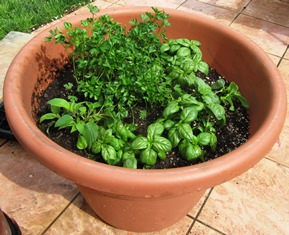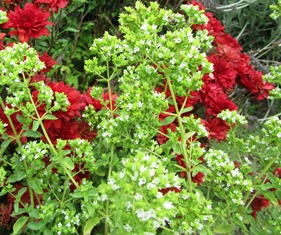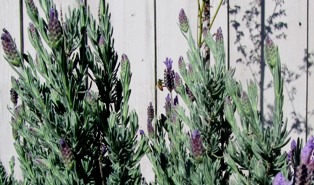Heirloom Herbs for the Kitchen
The green stalks of the red and yellow onions I planted in late summer are now up about a foot in a raised bed. The garlic that I planted around the same time is also poking up. Having onions, garlic, and fresh culinary herbs available year-round is not impossible in the Bay Area’s mild climate, especially when they are grown in cold frames, protected areas, and raised beds.
Some will re-seed themselves in the growing beds or around your yards. We’ve got Greek oregano and chives growing all over the place. Some of my favorites herbs include basil, cilantro, chervil, chives, dill, fennel, lemon balm, lavender, oregano, mint, marjoram, rosemary, thyme, parsley, sage, and savory.
We also grow a few ornamental herbs such as borage, hyssop, and catnip (for our new kitty), tea herbs (chamomile and mint), and medicinal herbs (like echinacea).
Herbs are easy to grow. Their blooms will attract insects beneficial to the garden. Butterflies and hummingbirds are also attracted. And herbs don’t need much–light, and porous soil, warmth, and decent drainage. For a light feeding of the herbs, we make chicken poop tea. With so many varieties of herbs available, why not tuck a few in your garden or in containers in a protected but sunny and warm area of your patio to enjoy in your culinary creations?
Plant Culinary Herbs for Yourself and the Honeybees
During my pre-rainstorm walk today around the farmette, I noticed honeybees foraging for nectar in the last blooms of the cosmos, nasturtiums, and rose geraniums.
This is the time of year that the bees search for autumn pollen and find it in the last flowers of a summer garden, but also in the blooms of lavender, heather, thistle, balsam, and eucalyptus.
In the spring, I planted a large pots of culinary herbs on my patio to use in cooking. The mixture of plants included sage, parsley, marjoram, chives, sweet basil, rosemary, English thyme, Greek oregano, Lebanese mint, chocolate mint, lemon bee balm, spearmint, and French tarragon.
If you enjoy using such herbs in autumn and winter soups, teas, or breads, for example, consider planting pots of herbs to grow on the patio or on a shelf in a garden window or on the window sill. The plants will brighten the cooking area on dreary dark days and, with just a snip, add flavor to your culinary creations.
Grow mint in pots if you don’t want it spreading over your yard. The same is true for the Greek oregano and also English thyme and French tarragon–those plants will grow beautifully even though confined in clay pots, old urns, or even half wine barrels.
In early autumn, there is a diminishing amount of nectar (in blooms) available for the bees. This is the known as the nectar gap–when the sources of nectar for the bees are minimal and new sources have not yet appeared. This time of the year to think about planting for yourself and also the honeybees.
 Facebook
Facebook Goodreads
Goodreads LinkedIn
LinkedIn Meera Lester
Meera Lester Twitter
Twitter








